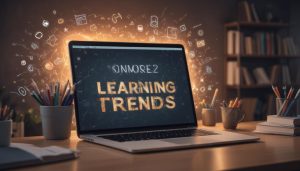Why Digital Literacy Skills Matter for Your Future
Aiden Foster August 22, 2025
Explore how building digital literacy skills can open new opportunities in education, careers, and everyday problem-solving. Learn how digital fluency impacts life and why it is a crucial skill for personal, academic, and societal growth.
Understanding Digital Literacy in Modern Society
Digital literacy means more than just knowing how to use a computer or smartphone. It involves understanding how to find, assess, and responsibly use information from the internet and other digital sources. As technology becomes central to daily life, digital literacy skills are crucial for students, workers, and citizens. People who sharpen these abilities are often better equipped to manage tasks, solve problems, and adapt to changing demands in education and employment. Today’s classrooms and workplaces are designed with digital tools in mind, making digital literacy a required skill, not a luxury.
The evolution of digital education has transformed how knowledge is shared and acquired. Learners who build competencies in digital research, content creation, and online safety can collaborate more efficiently and engage with a global audience. This shift makes digital literacy vital for academic achievement, as assignments, discussions, and research increasingly occur online. In fact, digital learning platforms now deliver most school and university content, making digital skills foundational for success.
Society expects individuals not only to consume digital content but to participate in its creation and evaluation. Being digitally literate includes understanding digital citizenship, privacy rights, and how to spot misinformation. Those who lack digital skills might struggle to access crucial services, participate in civic life, or even secure employment, as hiring managers actively look for candidates with proven digital fluency. Clearly, learning digital skills can be a defining factor in shaping both personal and societal progress.
The Core Elements of Digital Literacy
Digital literacy covers a broad set of abilities. At its heart are information literacy, communication skills, and technical proficiency. Information literacy involves knowing how to search for, evaluate, and use information effectively. This skill helps people recognize credible sources and avoid misinformation or scams—an essential safeguard in an online landscape filled with unreliable data. Technical proficiency is the foundation: navigating software, managing files, and using cloud-based tools are daily requirements for students and professionals alike.
Communication is also central to digital literacy. Today’s learners must be comfortable conveying ideas across numerous platforms, such as discussion forums, video calls, or project management apps. Effective communication requires the ability to select the best tool for the message, maintain digital etiquette, and collaborate with diverse groups. Classroom projects and remote work arrangements now routinely rely on teamwork across digital channels, placing a premium on these abilities.
Critical thinking underpins all aspects of digital literacy. Analyzing, synthesizing, and applying information are as important online as in traditional settings. Digital citizens must question sources, interpret digital footprints, and make informed choices rapidly. As data privacy and online safety concerns grow, digital literacy also includes protecting one’s personal information and practicing responsible online behavior, such as respecting intellectual property and understanding the implications of digital sharing.
Why Schools Prioritize Digital Literacy Education
Today’s schools view digital literacy as foundational. As academic materials, communication, and assignments move online, students who lack digital competencies risk falling behind. Many schools now integrate digital citizenship and media literacy programs into the core curriculum. These initiatives help students distinguish trustworthy sources, recognize cyberbullying, and become mindful of their digital footprints. By providing early access to these skills, schools better prepare students for advanced studies and the workforce.
Interactive platforms and learning management systems have become standard in educational environments. Teachers assign homework, facilitate group projects, and deliver feedback through online portals. According to recent national policies, digital literacy is considered as significant as reading and mathematics in K-12 settings. Educational systems often partner with technology providers or nonprofit organizations to offer targeted training, boosting both teacher and student confidence in digital spaces (Source: https://www.ed.gov/oii-news/ensuring-strong-and-equitable-digital-learning).
Assessments and standardized tests frequently include digital components, reinforcing the importance of developing these skills early. As schools bridge the digital divide, they empower more learners to participate fully in digital society. Digital literacy also fosters lifelong learning, encouraging students to seek additional certifications, participate in online communities, and develop problem-solving approaches that transfer to various areas of life.
Digital Literacy and Workplace Readiness
The modern job market demands a range of digital skills for entry-level to leadership positions. Employers value candidates who can easily adapt to new digital tools, communicate across formats, and troubleshoot technological issues. Even traditional industries, like healthcare or logistics, now use advanced software, electronic records, and digital collaboration platforms. Digital literacy has shifted from a “nice-to-have” to an essential requirement for gaining and advancing in employment.
Professional development increasingly incorporates online training, webinars, and remote work technology. Being literate in digital environments is necessary for navigating applicant tracking systems, creating digital resumes, and mastering virtual interviews. As businesses embrace hybrid or fully remote work, the importance of cyber hygiene and privacy awareness intensifies. Those who demonstrate digital competence stand out as effective, adaptable team members who can thrive in changing roles.
Digital literacy also allows workers to embrace lifelong learning. Many employers provide free courses or promote micro-credentialing so employees can update their skills without returning to a classroom. Accessible online learning platforms create opportunities for all, helping employees adapt to new software, understand trends in artificial intelligence, and manage data responsibly. This adaptability is key for career security as automation and digital transformation continue to reshape industries (Source: https://nces.ed.gov/pubs2019/2019171.pdf).
Bridging the Digital Divide
Not everyone has equal access to digital resources. The “digital divide” highlights gaps in technology access and skills between different communities, especially in rural areas or among under-resourced families. Closing this gap ensures everyone benefits from online education, civic engagement, and modern job opportunities. Policymakers and nonprofits often collaborate to provide affordable broadband, laptops, and digital literacy classes to underserved populations (Source: https://digitalinclusion.org/).
Libraries, schools, and community centers frequently offer training in basic computer use, internet navigation, and online safety. These inclusive programs empower marginalized groups to navigate online health resources, government benefits, and distance learning platforms. Digital inclusion also requires addressing language barriers, disabilities, and age-related learning differences. Building an equitable digital society means offering targeted programs and adaptive technologies for all learners.
Bridging the digital divide builds social capital and strengthens communities. As more individuals access technology and training, group collaboration and shared knowledge improve. This ripple effect supports local economies and fosters civic engagement, preparing society to meet the challenges of an increasingly connected world. Broadening digital access is not only a matter of fairness, but a necessity for sustainable community growth in the digital age.
Lifelong Learning and Digital Empowerment
The pace of technological change means digital literacy is an ongoing process, not a one-time lesson. Lifelong learning opportunities allow people to keep pace, whether through online courses, workshops, or self-guided study. Many universities, public libraries, and nonprofit groups offer free or low-cost programs that help adults discover new tools or stay updated on evolving trends (Source: https://www.open.edu/openlearn/education-development/education/what-digital-literacy).
Digital empowerment also involves using technology for personal growth and community action. Social media, blogs, and podcasts enable individuals to share stories, raise awareness, and organize civic events. While these platforms offer broad reach, they also challenge users to filter reliable information and guard against misinformation. Digital literacy empowers individuals to act as informed creators, contributors, and leaders online.
Building and maintaining digital literacy is a collective effort that helps individuals pursue higher education, enhance their careers, or advocate for causes they believe in. Staying curious, seeking new information, and refining online strategies contribute to digital wellbeing. Ultimately, digital literacy provides the confidence and skills needed to adapt and thrive in a rapidly evolving world, making it a lifelong asset for all generations.
References
1. U.S. Department of Education, Office of Educational Technology. (2022). Ensuring strong and equitable digital learning. Retrieved from https://www.ed.gov/oii-news/ensuring-strong-and-equitable-digital-learning
2. Organisation for Economic Co-operation and Development (OECD). (2021). Skills for a digital world. Retrieved from https://www.oecd.org/education/skills-for-a-digital-world.htm
3. National Center for Education Statistics. (2019). Indicators of school crime and safety. Retrieved from https://nces.ed.gov/pubs2019/2019171.pdf
4. Digital Inclusion Alliance. (2023). Bridging the digital divide. Retrieved from https://digitalinclusion.org/
5. Open University. (2023). What is digital literacy? Retrieved from https://www.open.edu/openlearn/education-development/education/what-digital-literacy
6. Pew Research Center. (2021). Internet and technology trends. Retrieved from https://www.pewresearch.org/internet/fact-sheet/internet-broadband/







